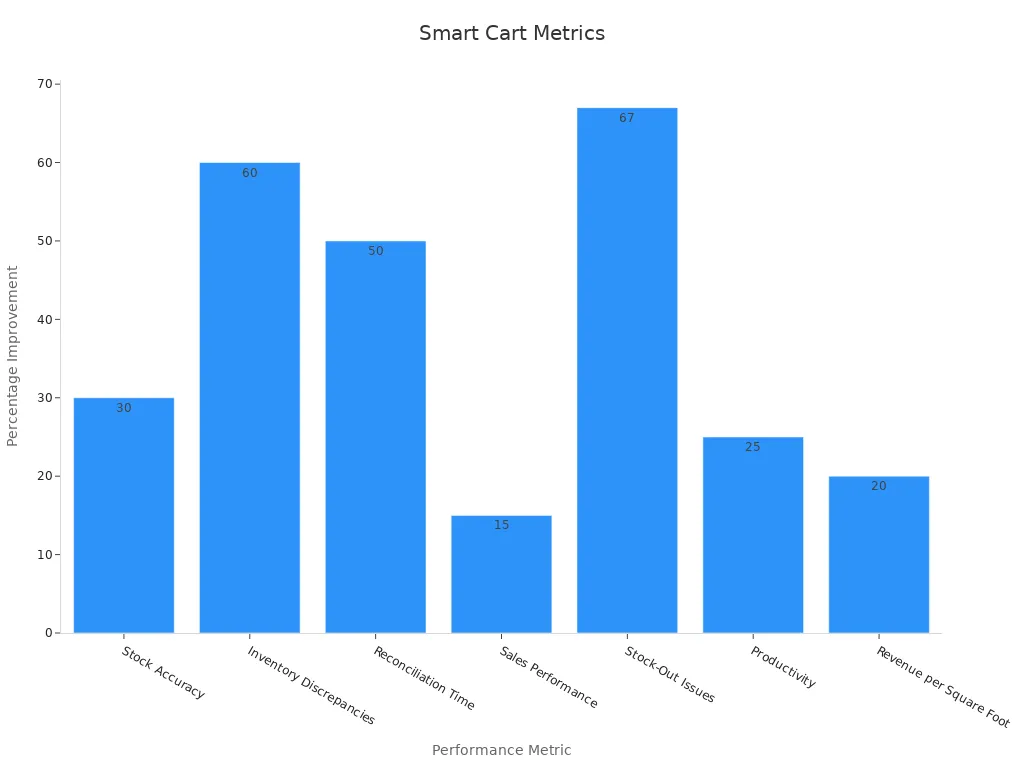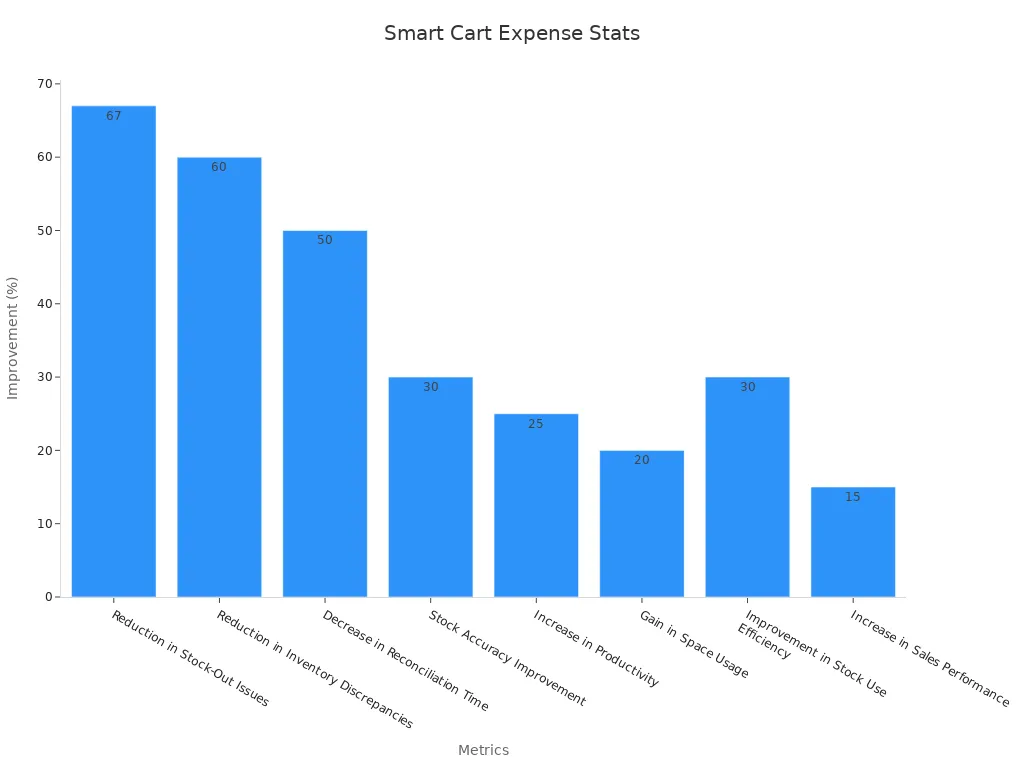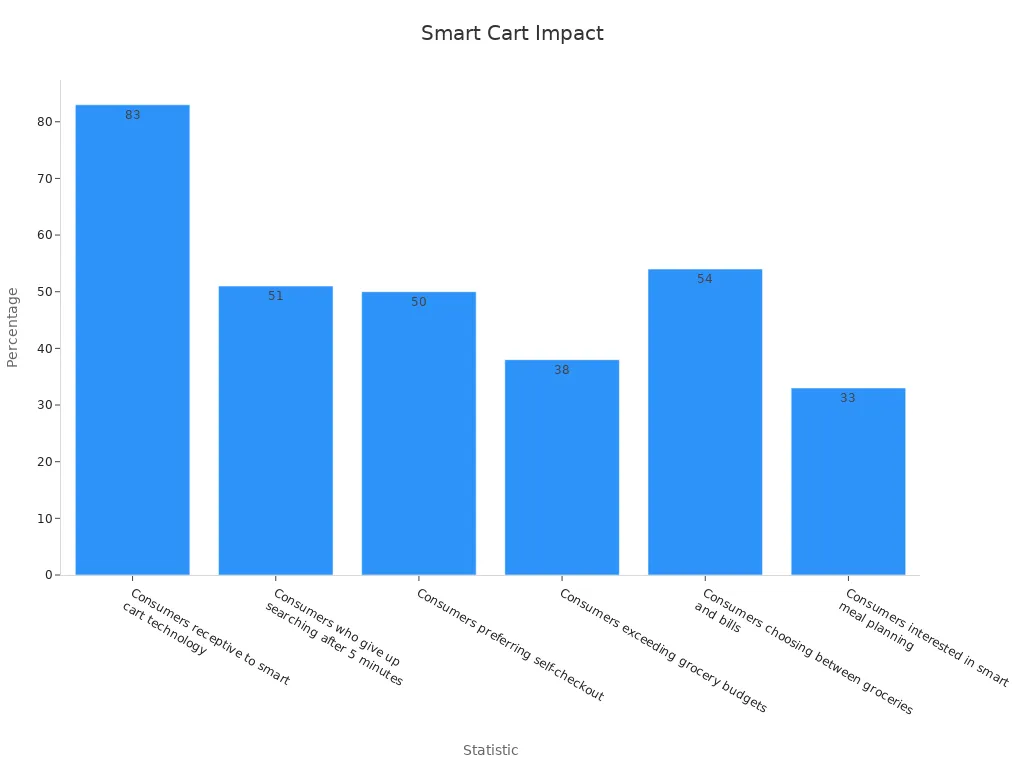Go Cart Shopping Carts: Combining Speed and Convenience for Enhanced Shopping Experiences

Go Cart shopping carts change how you shop by giving you both speed and convenience. You grab a smart shopping cart, scan your items as you go, and pay without waiting in line. Thanks to AI smart carts, you see real-time spending updates and get product suggestions that match your needs. Over 60% of grocers say these smart carts improve the shopping experience for customers and help stores run better. With features like contactless payments and navigation aids, smart shopping carts make every trip smoother for all customers.
Key Takeaways
Go Cart smart shopping carts speed up your shopping by guiding you to products and letting you pay right from the cart, so you avoid long lines.
These carts show your spending in real time, helping you stay on budget and find deals that match your preferences.
Checkout-free shopping lets you finish quickly and leave without waiting, making your trip faster and more convenient.
Electric and smart carts improve mobility for everyone, including people with disabilities or those carrying heavy items.
Stores benefit from smart carts by running more efficiently, reducing labor costs, and improving stock management, which leads to better shopping experiences for you.
AI Smart Carts & Shopping Experience

Speed & Convenience
When you walk into a store with ai smart carts, you notice the difference right away. These smart shopping carts use AI, computer vision, and IoT to help you shop faster and smarter. You can find products quickly because the cart guides you with digital maps and wayfinding tools. If you need help, real-time assistance pops up on the cart’s screen. You never have to wander the aisles searching for that last item on your list.
Smart shopping carts also track your spending as you go. You see your total in real time, so you stay on budget. The cart suggests deals and products based on your preferences, making your trip feel more like online grocery shopping. This smart cart integration brings the best parts of e-commerce innovation into the store. You get the speed of digital shopping with the personal touch of being in a real store.
Here’s a look at how ai smart carts improve store performance:
Performance Metric | Reported Improvement |
|---|---|
Stock Accuracy | Increased by 30% |
Inventory Discrepancies | Reduced by 60% |
Reconciliation Time | Decreased by 50% |
Sales Performance | Increased by 15% |
Stock-Out Issues | Reduced by 67% |
Productivity | Increased by 25% |
Revenue per Square Foot | Increased up to 20% |

You feel the convenience right away. No more guessing prices or waiting for help. Smart shopping carts give you control and save you time. Grocery stores see higher sales and better stock management. You get a seamless experience that feels just like e-commerce but with the bonus of seeing and touching products.
Smart cart integration also brings these benefits:
You can bag groceries as you shop.
Digital screens show personalized promotions.
Built-in scales handle produce and random weight items.
Integrated payment terminals let you pay right from the cart.
You get notifications when your deli or pharmacy order is ready.
All these features make shopping carts smarter and your trip smoother. You spend less time in the store and more time doing what you love.
Checkout-Free Shopping
Imagine finishing your shopping and walking straight out the door. With ai smart carts, you skip the checkout process completely. These carts use smart sensors, cameras, and AI to track every item you add. When you finish, you pay right from the cart or your phone. You never wait in line. This is frictionless shopping at its best.
Many automated and smart stores now use this technology. Amazon Go, Zabka, Carrefour, and other grocery stores let you pick up what you need and leave. The system charges your account automatically. You get the same speed and convenience you expect from online grocery shopping, but in a real store.
Here’s how checkout-free shopping works in different countries:
Retailer | Country | AI Technology Application Description |
|---|---|---|
Amazon Go | USA | Uses AI video surveillance and sensors to let customers pick items and leave without checkout lines; charges accounts automatically. |
Zabka | Poland | Tests cashier-less stores with AI tracking purchases, allowing customers to exit without traditional checkout. |
Carrefour | France | Experiments with AI systems that scan items during shopping and calculate totals automatically, eliminating checkout lines. |
Ahold Delhaize | The Netherlands | Explores AI-enabled stores where purchases are tracked in real-time and accounts charged upon exit, streamlining shopping. |
Sainsbury’s | UK | Tests AI technology to monitor purchases and charge customers automatically, improving shopping experience. |
7-Eleven | Japan | Implements AI systems that detect items and process payments via mobile apps, removing the need for cashiers. |
Spar | Austria | Uses AI to create cashier-less environments where purchases are tracked and charged automatically. |
Lidl | Germany | Experiments with AI checkout solutions enabling quick exits without traditional checkout processes. |
You might wonder how much faster this makes your trip. Studies show that checkout-free technology can cut the average shopping trip to about 25 minutes. Long lines used to cause 11% of shoppers to leave without buying anything. Now, with frictionless checkouts, you avoid those lines and finish faster.
Self-checkout has become a favorite for many. About 60% of customers prefer self-checkout over traditional lanes. In fact, 86% of shoppers say they avoid stores with long lines. With ai smart carts, you get the best of both worlds: the speed of e-commerce and the hands-on experience of shopping in person.
Smart shopping carts also help stores save money. Labor costs drop by up to 90% because fewer cashiers are needed. Retailers report a 25% rise in customer satisfaction and a 15% boost in productivity. You get a seamless experience, and stores run more efficiently.
Tip: If you want to save time and avoid crowds, look for stores with smart shopping carts and checkout-free shopping. You’ll enjoy a faster, more convenient trip every time.
Smart Cart Features
Real-Time Expense Tracking
You know that feeling when you get to the checkout and realize you spent more than you planned? Smart shopping carts fix that problem. These carts show you exactly how much you’re spending as you shop. You see your total on a screen, so you can make better choices and stick to your budget. If you want to swap out a pricey item for something cheaper, you can do it right away.
Smart carts use built-in calculators, product tracking, and digital displays. You scan each item as you put it in your cart. The cart adds up your total and even applies digital coupons. You never have to guess if you’re going over budget. This feature helps you feel more in control and less stressed about money.
Here’s a look at how real-time expense tracking changes the way you shop:
Metric | Improvement |
|---|---|
Reduction in Stock-Out Issues | |
Reduction in Inventory Discrepancies | 60% |
Decrease in Reconciliation Time | 50% |
Stock Accuracy Improvement | 30% |
Increase in Productivity | 25% |
Gain in Space Usage | 20% |
Improvement in Stock Use Efficiency | 30% |
Increase in Sales Performance | 15% |
Real-time tracking also helps stores keep shelves stocked and products available. When you pick up an item, the system updates inventory right away. This means you’re less likely to find empty shelves. Retailers use this data to restock faster and plan better sales.

You might notice that you spend less time in the store. Smart carts help you find what you need, track your spending, and check out quickly. You get a shopping experience that feels as easy as online grocery shopping. Many shoppers say they return to stores with smart carts because they trust the system and enjoy the control it gives them.
Tip: Use the real-time expense tracker to try new brands or take advantage of special deals without worrying about overspending.
Personalized Shopping Experiences
Smart shopping carts do more than just track your spending. They also create personalized shopping experiences that make every trip feel special. When you use a smart cart, it learns your preferences and suggests products you might like. If you often buy gluten-free snacks, the cart will show you new options or deals on those items. You get personalized recommendations right on the cart’s screen.
These smart features use AI and data from your past purchases. The cart can even help you plan meals, suggest recipes, or remind you about items you bought before. This feels a lot like e-commerce, where you get suggestions based on your browsing and buying habits. Now, you get that same level of service in the store.
Here’s how shoppers respond to smart cart features:
Statistic Description | Percentage / Value |
|---|---|
Consumers receptive to smart cart technology | |
Consumers who give up searching after 5 minutes | 51% |
Consumers preferring self-checkout | 50% |
Consumers exceeding grocery budgets | 38% |
Consumers choosing between groceries and bills | 54% |
Consumers interested in smart meal planning | 33% |

You get more value from every trip. Personalized shopping experiences can boost conversion rates by up to 915% and increase average order value by 369%. When you see deals and products that match your needs, you’re more likely to buy them. Stores also benefit because you come back more often and spend more each time.
Smart carts bridge the gap between e-commerce and in-store shopping. They use RFID, IoT, and real-time analytics to connect your physical shopping with your online data. You can get e-bills, track your purchases, and even receive personalized offers through your phone or email. This makes your shopping experience smoother and more connected.
Smart carts use RFID tags and mobile apps to sync your in-store purchases with your online account.
You get instant billing and digital receipts, just like online grocery shopping.
The system keeps your data safe with security features like biometric authentication.
Smart carts can suggest sales, help you find products, and even guide you to the right aisle.
Note: Personalized shopping experiences make you feel seen and valued. You get the best of both worlds—smart technology from e-commerce and the hands-on fun of shopping in person.
Smart shopping carts are changing the way you shop. You get real-time expense tracking, personalized recommendations, and a seamless blend of online and in-store features. Shopping feels easier, faster, and more enjoyable. You stay in control, save money, and discover new products every time you visit the store.
Accessibility & Mobility

Electric Shopping Carts
You might notice that electric shopping carts are popping up in more stores. These smart carts help you move around with less effort. If you have trouble walking or just want a smoother trip, electric shopping carts make shopping easier. You sit down, press a button, and the cart moves for you. This smart technology gives you freedom to shop at your own pace.
Electric shopping carts use sensors and smart controls to avoid obstacles. You do not have to worry about bumping into displays or other shoppers. The smart system helps you steer and stop safely. Some electric shopping carts even have voice navigation. You can ask the cart to guide you to the bakery or dairy section. This makes your trip faster and less stressful.
Stores use electric shopping carts to help everyone feel welcome. If you have a disability or get tired easily, you can still enjoy shopping. These smart carts also help parents with young kids or anyone carrying heavy bags. You get more independence and comfort every time you visit.
Enhanced Mobility Solutions
Smart mobility solutions go beyond just electric shopping carts. Stores now use smart video analytics and AI to track how you move through the aisles. This helps them design layouts that make shopping easier for you. Here are some ways stores use smart mobility solutions:
AI and video analytics track your path and time spent in each section. Stores use this data to improve layouts and make products easier to find.
Placing important items at aisle ends encourages you to explore more aisles and discover new products.
Different layouts, like grid or racetrack, change how you move and how long you browse.
Smart systems collect and analyze video data to see what works best for shoppers like you.
Pilot studies show that smart navigation tools help you avoid obstacles and find your way in large stores. Some electric shopping carts use LiDAR and deep learning to detect objects and guide you safely. Voice navigation and spatial sound help you know where to go. Devices like the EyeCane give extra help for those with vision challenges.
You get a better experience with these smart solutions. You spend less time searching and more time enjoying your trip. Stores see higher sales and happier customers. The motorized shopping cart is just one example of how smart technology makes shopping better for everyone.
Retailer Benefits & Challenges
Operational Efficiency
You see big changes in grocery stores when smart technology steps in. Smart electric shopping carts do more than just help you shop. They help stores run better and faster. When you use a smart cart, you scan and pay right on the cart. This means fewer lines at self-checkout and less waiting for you and other customers. Stores can move cashiers to help with stocking or customer service, which makes the whole place work smoother.
Smart carts also help stores keep track of what’s on the shelves. Real-time data shows what needs restocking and what’s selling fast. This cuts down on food waste because smart carts highlight items that are about to expire. You help stores save money and reduce waste just by shopping. Stores also use smart carts to show ads and deals, which brings in extra money. Walmart, for example, made $2.7 billion from retail media in 2022.
Here are some ways smart carts boost efficiency:
Shrinkage losses drop because of better security features.
Stores need fewer cashiers, so checkout moves faster.
Real-time inventory data helps with shelf-stocking.
New financial models, like subscriptions, help stores save money.
Tip: Smart carts make your trip faster and help stores run better at the same time.
Cost & Adoption
Switching to smart electric shopping carts brings both savings and challenges. Stores spend less on labor because they need fewer checkout stations. Smart carts encourage you to buy more by showing you deals and making shopping easier. This means bigger basket sizes and more sales for stores. But, there are hurdles too. Hardware like cameras and sensors costs a lot. Stores must connect smart carts to their systems, which can get tricky.
You might notice that some customers need time to trust and accept smart carts. Stores work hard to build trust and make sure everyone feels safe. Safety matters for both you and the store. Smart carts come with safety measures like anti-theft tech and secure payment systems. Stores also train staff to help you use the carts and watch for safety risks.
Here’s a quick look at real-world examples:
Aspect | Caper.ai Highlights | |
|---|---|---|
Cost Efficiencies | Less labor, fewer checkouts, bigger baskets | More labor efficiency, new ad revenue |
Challenges | Hardware cost, data integration, trust | Hardware investment, customer adaptation |
Safety Measures | Anti-theft, secure payments | Secure payments, easy interface |
Smart carts change consumer behavior and make shopping easier for everyone. Grocery stores see better results, but they must balance cost, safety, and customer trust. You get a safer, faster, and smarter shopping trip.
Go Cart shopping carts powered by AI give you a faster, safer, and more personal shopping trip. You get real-time help, easy checkout, and features that blend e-commerce with in-store fun. Retailers see up to 15% more revenue, but they must focus on safety and help everyone use new tech.
If you run a store, start small and train your team. The future looks bright as AI smart carts connect e-commerce and stores, making shopping smarter for everyone.
FAQ
How do you use a Go Cart smart shopping cart?
You grab a cart, scan your store loyalty card, and start shopping. The cart guides you with a screen. You scan each item as you add it. When you finish, you pay right on the cart and walk out.
Are Go Cart shopping carts safe for your personal data?
Yes, your data stays secure. Stores use encryption and secure payment systems. You can also set up extra security, like PINs or biometrics, for more protection.
What if you need help using a smart cart?
You can tap the help button on the cart’s screen. Store staff will come to assist you. Many stores also have quick-start guides or video tutorials right on the cart.
Can you use coupons or loyalty rewards with smart carts?
Absolutely! You scan your loyalty card or app at the start. The cart applies digital coupons and rewards automatically. You see your savings in real time.
Tip: Always check the cart’s screen for special deals or extra savings before you check out!
See Also
Transforming Retail Access With Innovative Grocery Vending Solutions
Understanding Walgreens Self-Checkout: Benefits And Retail Obstacles
Modern Retail Advantages Of AI-Driven Combo Vending Machines
Cloudpick Technology Delivering Seamless Cashierless Shopping Experiences
Revolutionizing Online Store Management With AI-Powered E-Commerce Tools
